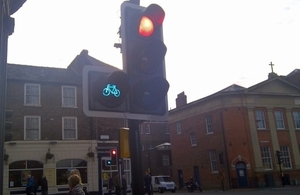Cycle-only green lights installed in York
How and why City of York council installed a green light on Mickelgate that lets cyclists move off before other traffic.

Green light filter for cyclists.
What we did
City of York council provided a green signal for cyclists which allows them to move off before other traffic.
When we implemented this in 2010, it was the first example in the UK of such an early start arrangement for cyclists.
Cyclists are detected within the Advanced Stop Line (ASL) on Queen Street. This triggers the main signals to give a 3 second cyclists-only signal, plus a further 2 seconds normal red-amber phase, before other traffic is released on a standard green signal. This gives cyclists a head start over other traffic to negotiate the busy junction and to make their intentions clear to drivers behind.

Cyclist at Queen Street junction.
Why we did it
We did some analysis that showed that there had been a lot of collisions involving cyclists setting off from traffic lights at one of the junctions on Queen Street. This was because both outbound lanes on Queen Street were available for the dominant right turn movement, but quite a few drivers were wrongly using the right hand lane to carry straight on. This led to conflict with cyclists who were correctly using the left hand lane to turn right. The problem was made worse as the road is uphill which means that cyclists set off slowly.
Following implementation of the cycle signals (along with other alterations to this junction) there has been a reduction in collisions involving cyclists. The signals being staged so that there is an all-pedestrian stage just prior to the advanced green cycle light phase may also have helped, so no vehicles should be moving at the point where the cycle light becomes illuminated.
Overall feedback has been positive, though some cyclists would like the signal phase extended for longer.
How we did it
The proposals were initially considered a trial measure and the Assistant Director signed off the scheme as a departure from standards with an application submitted to the DfT for formal authorisation.
A consultation questionnaire was distributed to every household within York. This questionnaire gave potential options for changes to the junction, which included the proposal for an early start cycle green signal for outbound Queen Street cycles.
Of the questionnaires returned 71% were in favour of giving cyclists a head start over other traffic as part of the traffic signal sequence.
What we learned
There were some initial teething problems with the cycle signal not reliably being activated. The phase is only activated if the inductive loop detectors installed into the cyclists’ Advance Stop Line (ASL) box detects a cycle on them. Cyclists must remain within the box to trigger their signal. A lot of cyclists, anticipating trying to get ahead of traffic, moved to the front of the ASL and sometimes further forward. So without a bike actually on the loop the request for the cycle aspect was cancelled. In hindsight, it would have been better to cut the loops right at the front of the ASL to try to get them where most cyclists wait for the signals to change.
The ASL box itself is a standard 5m in depth and spans the 2 outbound traffic lanes and the cycle lane which feed into it. One issue with this is that the loops do not appear to be as sensitive as they would be if they were just in a single lane ASL box. On reflection it would have been advisable to combine inductive loop detection with above ground detection, such as microwave radar and / or infra-red.
There have been no reported problems with drivers misunderstanding what the green cycle aspect means.
Further information
For more information email Richard Holland on richard.holland@york.gov.uk